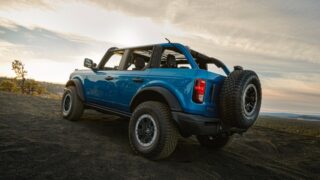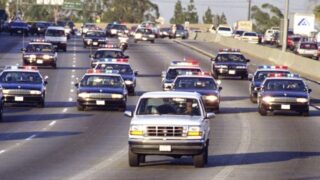By R.M. Ferguson
The purpose of this
article is to simply provide all the info I’ve gathered on the
subject in one, easy to print document and share it with others with
a common interest. The information was compiled from numerous sources
including the FTE forums and;
–
John’s F-Fun Hundred 2002 catalog
–
RB’s Obsolete 2002 catalog
–
Various websites with Ford rear end info
None
of it is original information. It was all gathered from the various
sources listed above. While believed accurate, I make no promises it
is. (I have tried to avoid the conflicting measurements offered in
several different charts found on the web.)
Part 1
: Rear ends that “will” fit in 53-56 F100s ;
My 54 F100
measures 55″ wide between the two narrowest points on the
backing plates. The flange to flange measurement (drum face to drum
face) is 61 ¼”. Based upon my “research”,
these rear ends will work;
1989 Lincoln Mark VII
– (bolt pattern unknown by the author.)
– Dimensions unknown by author.
1989 ““ 2001 – Ford Explorer ““ 59 ¼ – ½” flange to
flange.
– All explorer rear ends are the same 5 on 4 ½” bolt pattern.
– 8.8″ rear end – come with 3.25, 3.55, 3.73 and 4.11 gears.
– 89-94 drum brakes only.
– 94-97 drum or disc. brakes
– 97-01 disc. Brakes only
– Can use an 8″ rim with 3 ½” backspacing and P235/75R-15 tires
– Number 3 choice for ease of installation and price.
1957 ““1972 F100 9″ heavy duty – 5 on 5 ½” bolt pattern
– Is supposed to bolt right in without moving spring pads.
– Measures 61 ¼” flange to flange
– To switch to the 5 on 4 ½” car bolt pattern – Use two
driver’s side axles, both side backing plates and drums from
72-79 Torino, Ranchero, LTD II or 77-79 T-bird or Cougar on/in the
truck axle housing.
– Number 1 choice for ease of installation and price
1971 ““ 73 Mustang & Cougar. 9″ , but lightest duty of the 9″ family.
– Have the 5 on 4 ½” pattern
– Measures 60″ flange to flange
– Measures 54 ““ 55″ backing plate to backing plate.
– Comes with both 28 spline axles (weaker) and 31 spline axles (stronger)
– Oval hole in outer end of axle = 28 spline
– 2 large holes and counter-sunk center = 31 spline
– Number 2 choice for ease of installation and price.
1968 ““ 1971 Torino/Fairlane/Montego ““ 9″ but medium duty
– Measures 56 ““ 57″ backing plate to backing plate
1960-64 Ford Galaxie 9″ medium duty
– Measures 54″ flange to flange (?)
1979 Ford F100
– ” a little wide” but apparently is supposed to fit
1970 ““79 Ranchero/Torino 9″ high performance version
– Measures 56″ axle tube to axle tube.
As 9″ rear ends
are generally a 3″ O.D. on the housing where they attach to the
springs whereas the 53-56 housings are 2 ½”, a new set
of U-bolts, etc will be needed. Kits can be purchased from many
different street rod supply vendors.
Part 2: Methods for lowering ride of 53-56 F100s;
In my particular case
(a 1954 F100) the bottom edge of the extreme rear end of the frame is
17″ from the ground. The bottom edge of the running braces are
13-13 ½” off the ground. Additionally, the present
distance from the top of the rear end housing to the bottom of the
frame directly above the housing 8 ½” with the rubber
stop reducing that by 2″ to 6 ½” of upward
suspension travel (not including crush on the rubber stop).
The axle housing is mounted below the springs. 8 leaves for a total
thickness of 2 ½” and the spring perch height is aprox.
1 “.
Here
are the various avenues for lowering the rear suspension that I have
found;
-
Remove every
second leaf from the rear springs (removing a total of 3 leaves).
According (apparently ) to Mid-Fifty, keep 1,3,5,7 and the main
leaf. In theory this will lower the rear end approx. 0.31 “.
In reality it might yield a fraction more as it will soften the
suspension. Cost is zero.
This should not alter the pinion angle.
-
Utilize 2″
lowering shackles on the rear mounting end of the rear springs. It
is recommended that this be combined with moving the front spring
shackle up approx. 1 ½” (necessitates drilling new mounting
holes in the frame). This latter step will help to avoid altering the pinion angle. The
shackles run approx. $90.00 USD a pair circa 2002.
This may result in the upper edge of the rear shackle coming into
conflict with the bottom of the bed floor & may impact pinion angle.
This should yield a drop of 1 ½ – 2″.
-
Combine
alternatives # 1 & 2 above for approx. 2 to 2.5 ” drop .
-
Utilize mono-leaf rear springs. Available from several sources
including John’s F-Fun Hundreds & Vintage Ford . This should yield a
drop of 2 ““ 3″.
These run approx. $350.00 USD a pair circa 2002.
-
Utilizing reversed eye mono-leaf springs also available from same
sources as previous alternative will yield a drop of 3 1/2 ““ 5″.
These run approx. $350.00 USD a pair circa 2002. It is recommended you flip the front
shackle mount upside down to avoid the spring binding on the shackle mount.
-
Another alternative is to mount the differential housing on
top of the rear springs rather than it’s stock location under the springs.
Total drop achieved via this method would be approx. 4 – 4 ½”. Cost is
a bit of welding to move the spring perches from the top of the axle housing to the
bottom.
I am led to believe
that a minimum of 3″ travel is required to provide safe and
comfortable handling in everyday driving situations. Any of the
above combinations that reduce the suspension travel to 3″ or
less should be accompanied with C-sectioning the frame;
The March 2002 issue of
StreetRodder has an article involving No-Limits Eng. doing it in one
manner. Apparently they also offer a kit. Don’t know the price
or whether it bears any resemblance to the manner used in the
magazine article. Hopefully not”¦..requires extensive welding.
RB’s Obsolete
Auto also offer a “kit” that can be adapted to the frame
with some welding and cutting. It doesn’t say it in their catalog,
but it looks like it would give back about 1 ½” of
travel. Cost is approx. $110.00 USD . RB’s alternative looks
good (cosmetically).
Looking at a picture of
either alternative will quickly reveal that C sections aren’t
rocket science. It wouldn’t be that difficult to make your own.
But unless you have easy/free access to steel, it would be hard to
beat RB’s price.
|




